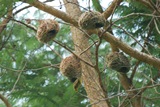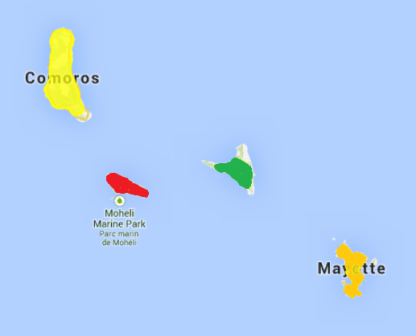Weaver species
Choose different species from drop-down list and press 'Go' button. See Full species list.Comoro Fody Foudia eminentissima
IUCN: Least concern Discovery: 057Categories: island, Foudia, nectar,
News items about species
Discovery
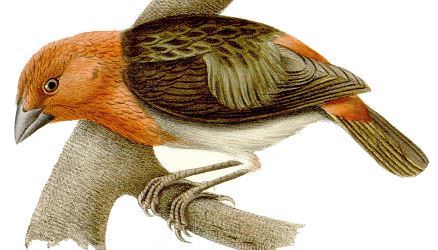
figure from Verreaux (1867) 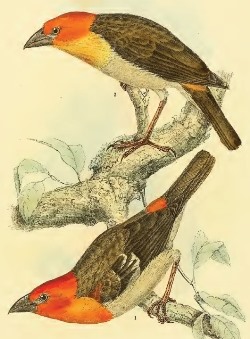
from Pollen (1868), top: immature male, lower: adult male 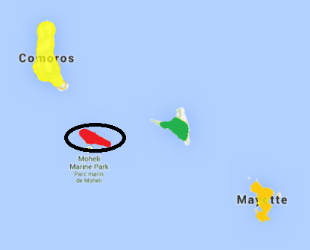
distribution, type locality circled IntroductionThe Comoro Fody was formally described by Charles Lucien Bonaparte, a French biologist and ornithologist. Around 1849 Bonaparte began work on preparing a classification of all the birds in the world, visiting museums across Europe to study the collections. In 1850, he published the first volume of his Conspectus Generum Avium which included 3 weavers. Bonaparte studied the type specimen of the Comoro Fody in the Paris Museum.The Comoro Fody was collected by Loius Rosseau. Rousseau travelled the western Indian Ocean on the French naval corvettes Prevoyante and Dordogne in 1839-1841. The Prevoyante visited Mayotte in 1840 and 1841 and the Dordogne visited Mayotte and Zanzibar at least in 1840 (Cheke 2011). The Comoro Fody may have been introduced to Zanzibar, and then collected there by Rousseau, or Rousseau mis-labelled his specimen. The Comoro Fody differs slightly in measurements and plumage on the different islands of the Comores, and Benson (1960) showed that the type specimen matches the subspecies on Moheli Island. The first illustration of a Comoro Fody is by Verreaux (1867) of the nominate subspecies. The next illustration was published the following year by Pollen (1868), but of subspecies algondae. Reichenbach (1863) mentioned the species, and provided an English name, but did not illustrate it. Scientific citationFoudia eminentissimus Bonaparte 1850 Consp. Gen. Av., 1, p.446 "Zanzibar", error for Mohe'li Island, fide Benson (1960, Ibis, 103b, p.101).Meaning of nameseminentissima - Latin. eminentissimus, very conspicuous, outstanding (super. of eminens, prominent).First English nameThe Zanzibar Foudi (Reichenbach 1863).Alternate namesGrand Comoro Fody, Johanna Fody, Mayotte Fody, Red Forest Fody, Red-headed Fody, Red-headed Forest Fody.CollectorLoius Rosseau.Date collected1840 - 1841.Locality collectedZanzibar = Moheli Island, Comores.Type specimensThe type specimen is in the Paris Museum. |
The above is based on Weaver Wednesday 2, a weekly series about the discovery of each weaver species.
This species text first appeared as
Weaver Wednesday [174] - Discovery [57]: Comoro Fody on 2015-10-14
1. Basic biology
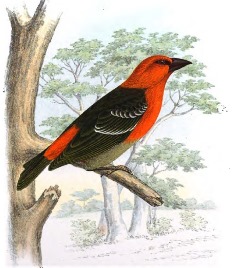
figure from Cabanis 1869 Distribution.
The Comoro Fody is found on the Comoro Islands (see map below, based on Birds of the Malagasy region). There are 4 subspecies, found on different islands:
Habitat. The Comoro Fody inhabits well wooded habitats and forested areas. On Mayotte it is not found in intact stands of evergreen forest. On Grand Comoro, Mohéli and Mayotte it is found close to sea-level. Food. The diet of the Comoro Fody is mainly insects, including beetles, grasshoppers, and ant pupae. The Comoro Fody also feeds on fruit and spiders. Breeding. The Comoro Fody is probably monogamous. It is territorial, and males sing from tree tops in their territories. The nest is globular with a side entrance near the top. There is usually a porch above the entrance. Nests may have a ceiling of moss. The eggs (clutch of 3) are pale blue, with a few fine spots. Possible nest predators include the exotic black rat, lemurs, and raptors. |
The above is based on Weaver Wednesday, a weekly series about weaver species.
This species text first appeared as
Weaver Wednesday [114]: Comoro Fody on 2014-08-20
2. Breeding facts
| Pair bond Monogamous Breeding season Oct-Mar on Mayotte Nest site suspended rarely 1 m above ground, most often higher than 10 m Nest building Male starts nest and, once female has accepted it, both sexes build, and female may complete the structure with little male participation Colony size No information Clutch size 2-3 eggs Egg colour pale blue-green, occasionally few black specks Egg size No information Incubation incubation by female only, period 13-16 days Chicks and nestling period chicks fed by both parents, male usually began feeding only after 3 days, nestling period 15-18 days |
Breeding information based on Handbook of the Birds of the World, Vol. 15.
3. Photos of Weaver Nests
No records yet - be the first to submit a PHOWN record!See PHOWN summary page for this species here.
PHOWN (Photos of Weaver Nests) provides valuable info on breeding distribution and colony sizes of weavers.
You can contribute by registering and submitting photos at Virtual Museum webpage.
4. Breeding distribution
Google map showing distribution (For species with small ranges you need to zoom in at the correct area to see the range):
yellow blob - range of weaver species; read more about this here.
![]() - PHOWN records with photos
- PHOWN records with photos
![]() - PHOWN records with no photos (Nest Record Cards, other records)
- PHOWN records with no photos (Nest Record Cards, other records)
![]() - Birdpix records
- Birdpix records
![]() - comments on out of range records, or interesting records
- comments on out of range records, or interesting records
![]() - type locality
- type locality
CLICK on the marker on the map to see individual record details.
5. Range changes
Not South African speciesThe above is based on Weaver Wednesday 3, a weekly series about range changes in South African weaver species.
This species text first appeared as
n/a








